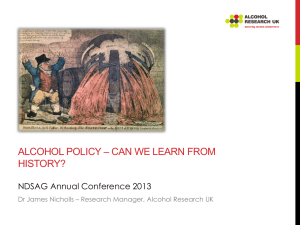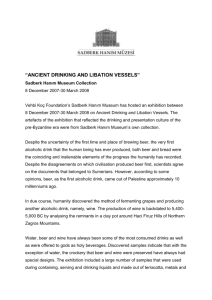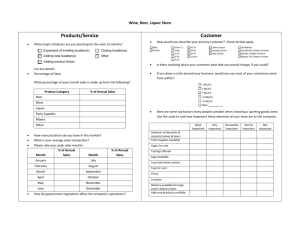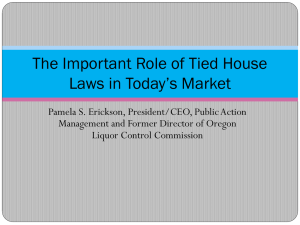Overview of Neurobiology of Addiction
advertisement
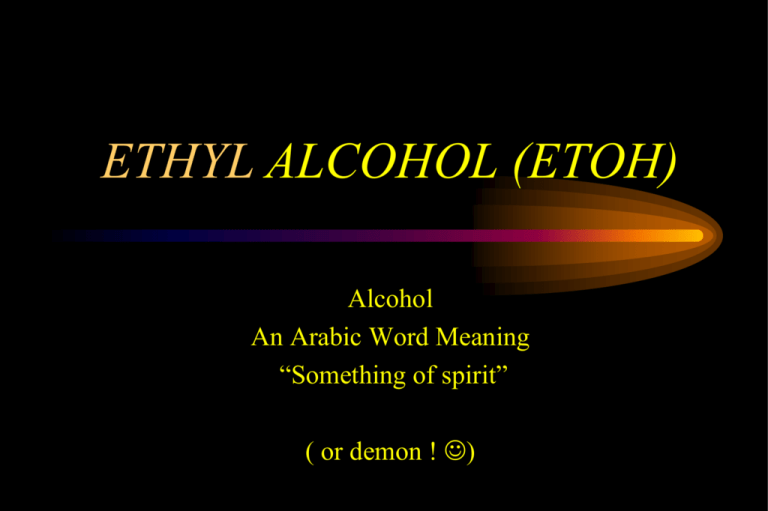
ETHYL ALCOHOL (ETOH) Alcohol An Arabic Word Meaning “Something of spirit” ( or demon ! ) Alcohol • Made from the fermentation of carbohydrates by yeast – Yeast are unicellular fungi • Fermented in every culture on earth at some point in time • Animals (monkeys and birds) consume fermented fruit Alcohol History • Probably the world’s oldest anodyne ( pain reliever) • Beers & wines since about 6400 BC – Berries, apples and honey • • • • Early use for spiritual ceremonies First brewery in Egypt 3700 BC Only natural fermentation around 800 BC Process of distillation in Arabia- the “Alembic Still” Jabir Ibn HAKAN, 721–815.. • just kidding …. “Hayyan” Alcohol History in Europe • 1500s - high alcohol consumption problems (reign of Henry VIII) • 1608 - first laws against drunkenness passed in England • Gin discovered in 1650 by Dutch physician – From corn mash poured over juniper berries • 1700s - gin epidemic – tried to regulate use - led to riots • Coffee & Tea & Methodist movement led to decline in alcohol use Alcohol History- in the U.S. • Brought from Europe by settlers • Production was encouraged • Drinking was condoned to point of drunkenness – 6 gallons/yr per capita • Consumption escalated in the Frontier regions – Aggressive and exploitive men. – Per capita consumption 7 gallons/yr. “Saloons” in the “Wild West” • Used as anesthetic in Civil War • Temperance Movement rise ( Dr. Benjamin Rush) The Volstead Act • 18th Amendment (1920) Illegal to produce alcoholic beverages Yet Increased number of drinking establishments Increased strength of organized crime Effectiveness is debatable was very unpopular 21st repealed 18th in 1933 – Happy Days are Here Again ALCOHOL TODAY • The worlds largest drug business: > $ 60 billion dollars/year in USA • 8 million junior high and high schoolers drink every week • Undergraduates in US spend $4.2 billion on booze: more than they spend on textbooks! High School Seniors Using Alcohol During the Past 12 Months PERCENT 100 80 60 40 20 0 85 90 95 00 05 Prevalence- context Past-month adolescent alcohol, cigarette, and marijuana use by grade according to the 2007 Monitoring the Future Survey. Consumption may start even earlier Alcohol Prevalence in US • 90% Ever drank • 65% Current drinkers (70% men and 60% women ) • >40% Temporary problems • 10-20% Abuse • 5-15% (One in twelve will develop alcoholism or alcohol abuse disorder ) Dependence (Lifetime) Alcohol-Pharmacology • Ethyl alcohol or ethanol • (not methyl alcohol) Alcohol: Forms • Naturally Fermented (max 14%) Any organic substance that has sugar content can be fermented Beer- typically made from grains Wine- typically made from grapes, but can also be made from fruits of all types Mead- honey…one of the earliest brews Distilled Alcohol -Spirits/Liquor Heat to evaporate water content Cooling to condense the ethanol Much higher alcohol concentrations Distilled (up to 95%) Bourbon (40-50%)-corn, rye Whiskey (40-50%)-distilled beers Gin (40%)any distillate flavored w/juniper berries Vodka (40%)-potato Tequila (40%)- agave cactus Everclear (95%) Proof ( 80 proof = 40% alcohol content) British Army used “proof” as a measure of concentration Poor alcohol on gunpowder and tried to light it Route/Absorption • Oral is by far the route of choice • Rapidly absorbed, primarily from small intestine – 20% stomach, 80% small intestine Of course there are always those who only learn from “hindsight!!” Oral Administration • Rapidly absorbed, primarily from small intestine – 20% stomach, 80% small intestine • Peak blood alcohol concentration (BAC) depends on: – – – – – – Amount and alcohol concentration of beverage Rate of drinking Food consumption and composition Gastric emptying and gastric metabolism Hepatic (liver) first pass Gender Metabolism • Metabolism – 90-98% metabolized in liver Alcohol Alcohol dehydrogenase Acetaldehyde Aldehyde dehydrogenase Acetate A constant 0.015% per hr metabolized Accumulation of acetaldehyde associated with headache, gastritis, nausea, dizziness (hangover) Computing BAC • 1 Standard drink = – 1 beer (12 oz) – 4 oz wine – 1 oz 100 proof liquor ( ½ oz pure ethanol) • Blood Alcohol Content – Blood Alcohol Content (a.k.a. blood alcohol level; BAL), represent the percent of alcohol in your blood (in mg /100 ml of blood). A BAC of .10 means that .1% of your bloodstream is composed of alcohol. One standard drink increases BAC by 0.025% on average. Computing BAC • Alcohol metabolization – 1 drink every 2 hrs – .01% every 40 min – BAC=NSD X (.025%) - NHD X (.015%) 0.08% BAC = legal intoxication Pharmacokinetics: Gender Differences • Gender Differences – in absorption • Differences in gastric ADH activity – in volume of distribution • Differences in body composition and total body water (TBW) – in metabolism • Differences in liver volume, ADH activity? • And other factors… Pharmacodynamics: CNS Effects • Alcohol is a CNS depressant • Apparent stimulatory effects result from depression of inhibitory control mechanisms in the brain • Characteristic response: Increased IQ and good looks. • JUST KIDDING! • euphoria, impaired thought processes, decreased mechanical efficiency, sedation Concentration-Effect Relationship BAC [%] Effects 0.02-0.03 Mood elevation. Slight muscle relaxation. 0.05-0.06 Relaxation and warmth. Increased reaction time. Decreased fine muscle coordination. 0.08-0.09 Impaired balance, speech, vision, hearing, muscle coordination. Euphoria. 0.14-0.15 Gross impairment of physical and mental control. 0.20-0.30 Severely intoxicated. Very little control of mind or body. 0.40-0.50 Unconscious. Deep coma. Death from respiratory depression (LD-50) Alcohol as a Reinforcer • Reinforcer: a substance whose pharmacological effects drive the user to continue to use it • Positive reinforcing effects: – Gain pleasure – Altered consciousness – Conform to behavior of peers • Negative reinforcing effects: – Relief of stress and negative emotions – Relief of withdrawal symptoms Alcohol as a Reinforcer: Neural Systems Animals will self-administer alcohol & show increased DA levels in the mesolimbic system (Vta- nucleus accumbens) Animals will bar-press for intra-cranial injections of alcohol into the VTA (ventral tegmental area) Alcohol activates neurons of the VTA-accumbens (and VTA-frontal cortex)…. leads to release of DA Negative Effects of Alcohol In general, people do things when under the influence that they would not do normally. Alcohol related Emotional/ Social Problems Alcohol Effects on Driving • Traffic crashes are the greatest single cause of death for persons aged 6–33. About 45% of these fatalities are in alcohol-related crashes.4 • Driving: 50% of all highway fatalities Movements such as Mothers against Drunk Driving may have had significant impact on DUI. Since 1980 (the year Mothers Against Drunk Driving was founded), alcohol-related traffic fatalities have decreased nearly 50 percent, from over 30,000 to under 15,500 . Binge Drinking Number of Days in the Past 30 in Which Drinkers Consumed 5 or More Drinks, by Age and Gender. Source: SAMHSA data from 2005 NSDUH Binge Drinking Figure 2 Past-month alcohol use (any, binge, heavy) by age. Binge Drinking- Fun Fun Fun! • Memory: blackouts • Hangover • Overdose Hangover! • Hangover symptoms typically begin when your blood alcohol drops significantly and is at or near zero. They're usually in full effect the morning after a night of heavy drinking. • • • • • • • • • Fatigue , Thirst Headaches and muscle aches Nausea, vomiting or stomach pain Poor or decreased sleep Sensitivity to light and sound Dizziness or a sense of the room spinning Rapid heartbeat , Bloodshot eyes Shakiness , Decreased ability to concentrate Mood disturbances, such as depression, anxiety and irritability BLACKOUTS • Alcohol interferes with the ability to form new long–term memories, • • As the amount of alcohol consumed increases, so does the magnitude of the memory impairments. Large amounts of alcohol, particularly if consumed rapidly, can produce partial (i.e., fragmentary) or complete (i.e., en bloc) blackouts, which are periods of memory loss for events that transpired while a person was drinking. • Blackouts are much more common among social drinkers—including college drinkers—than was previously assumed, and have been found to encompass events ranging from conversations to intercourse. Alcohol Toxicity • • • • • • • • Confusion or stupor, as if in a daze Vomiting that persists Seizures Slow breathing (less than eight breaths a minute) Irregular breathing Blue-tinged skin or pale skin Low body temperature (hypothermia) Unconsciousness — "passing out" Negative Effects of Alcohol- Aggression • >50% assaults and homicides are alcohol related • At least one-half of all violent crimes involve alcohol consumption by the perpetrator, the victim, or both (Collins and Messerschmidt 1993). Alcohol and Aggression • Shuntich & Taylor study of alcohol and aggression in the laboratory • Alcohol increased intense and potentially injurious shock delivery • • 35% of suicide attempts Alcohol and Sexual Behavior • Lechery, sir, it doth provoke, and... • It doth unprovoke!… It provokes the desire, but takes away the performance. Macbeth nonetheless a common agent in Sexual Assault • Approximately one-half of all sexual assaults are committed by men who have been drinking alcohol (the estimates for alcohol use among perpetrators have ranged from 34 to 74 percent). • Similarly, approximately one-half of all sexual assault victims report that they were drinking alcohol at the time of the assault(Abbey et al. 1994; Crowell and Burgess 1996). Adverse ALCOHOL EFFECTS • Alcohol and Sleep • Many college students may think that moderate drinking has no negative effects on learning and health. As little as one drink, however, can impair a person’s ability to get a good night’s sleep, which can lead to more significant problems. Adverse Effects of Chronic Drinking • • • • Cirrhosis of the liver Wernicke-Korsakoff syndrome Fetal Alcohol syndrome Alcoholism YEARLY COSTS IN US $300 Billion Overall $71 Billion Direct Costs 22,000 Deaths + 2,000,000 Injuries 4,600,000 Damaged Vehicles 15% - 25% Healthcare Budget 90% of Liver Disease 72% of Pancreatitis 41% of Seizure Disorders 13% of Breast Cancers Copyright Alcohol Medical Scholars Program 48 Health Benefits? • Moderate Drinking (Men 3 or less/day, Women 2 or less/day, Never more than 5) • Stress inoculation? • Bone mineral density Alcohol and CVD • • The strongest medical evidence exists for the link between moderate drinking and a reduced risk of heart disease. Dr. Kenneth Mukamal examining the roles of drinking patterns and heart disease found, after 12 year of follow-up, that older men who consumed alcohol between three and seven days a week had fewer heart attacks than men who drank once a week. Alcohol and CVD • Benefits of alcohol are thought to be mediated by actions on blood flow to the heart and to the brain. – alcohol‘ increases the good cholesterol (HDL cholesterol). – alcohol may lower heart attack risk by acting as a blood thinner. Increased risk of CVD among people who drink to excess even occasionally. Alcohol Benefits- Dementia? Studies from both the U.S. and Europe have suggested that older adults who were drinking moderately may have a lower risk of dementia. Tolerance: Definitions • Dispositional –increased production of alcohol dehydrogenase. • Behavioral-learned compensations • Functional-after chronic alcohol consumption brain functions adapt to compensate • Cross Tolerance: Tolerance to one drug leads to tolerance to other drugs in a class – – – – Benzos Barbs General Anesthesia GHB Withdrawal • Phase I ( BACs nearing zero) - Tremors, sweating, anxiety, perspiration, headache, nausea, vomiting • Phase II ( 24 hrs of abstinence) -As withdrawal continues, one can have grand mal seizures • Phase III- DTs (Delirium Tremens -around 30 hrs abstinent) – Severe agitation, hallucinations, high fever, delirium. Lasts 3-4 days • The most likely of all drug withdrawals to be fatal Dependence • DSM-IV Disorder • It is the model for all other substance dependence Prevalence of alcohol dependence by Age Prevalence of past-year DSM–IV alcohol dependence in the United States. Source: 18+ years: 2001–2002 National Epidemiologic Survey on Alcohol and Related Conditions, 12–17 years: National Survey on Drug Use and Health, 2003. • • • • • • • • • • • • • • • Alcohol Timeline 6000-4000 BCE Viticulture, the selective cultivation of grape vines for making wine, is believed to originate in the mountains between the Black and Caspian seas (modern Armenia). c. 3000-2000 BCE Beer making flourishes in Sumerian/Mesopotamian civilization (modern day Iraq) with recipes for over twenty varieties of beer recorded on clay tablets. 3000-2000 BCE Wine production and trade become an important part of Meditaranean commerce and culture. Ships carry large quantities between cities. 2200 BCE Cuneiform tablet recommends beer as a tonic for lactating women. 3000-1000 BCE Beer is unrefined and usually drunk through straw because it had large quantities of grain and mash in it. c. 1800 BCE Beer is produced in quantity in northern Syria. 1500 B.C. Wine is produced commercially in the Levant and Aegean. • • • • • • • • • • • • • • 900-800 BCE Extensive, large scale vineyards laid out in Assyria (modern Iraq) produced over 10,000 skins of wine for the new capitol at Nimrud by Assurbanipal II. c. 800 BCE Distillation of barley and rice beer is practiced in India. c. 50 BCE Dionysius of Halicarnassus writes "the Gauls (french) have no knowledge of wine.. but used a foulsmelling liquour made of barley rotted in water (beer)." c. 500 Wine making reaches Tang China along the Silk Road. 768 First specific reference to the use of hops in beer from the Abbey St. Denis in France by King Pepin le Bref. 1100 Alcohol distillation is documented by the medical school at Salerno, Italy. The product of the distillation is named 'spirits' in reference to it being the extracted spirit of the wine. Middle Ages Distillation of grain alcohol in Europe follows the earlier distillation of wine. • • • • • • • • • • • • • • 1516 German Beer Purity Law ("Rheinheitsgebot") makes it illegal to make beer with anything but barley, hops, and pure water. Early 1500's Benedictine, a cognac-based alcohol with added herbs, is developed at the monastery in Fecamp, Normandy. 1525-1550 England. Excessive use of distilled spirits first becomes apparent. 1524-1556 Viticulture spread through Peru, Chile and Argentina. 1500's The term 'alcohol' is now used specifically to refer to distilled spirits rather than its previous general meaning of any product of the process of vaporizing and condensing. 1550 - 1575 England. Thomas Nash describes widespread inebriety in Elizabethan England; drunkenness is mentioned for the first time as a crime, and preventive statutes multiply. 17th Century Use of hashish, alcohol, and opium spreads among the population of occupied Constantinople • 1600 - 1625 • England. During the reign of James I, numerous writers describe widespread drunkenness from beer and wine among all classes. Alcohol use is tied to every endeavor and phase of life, a condition that continues well into the eighteenth century. • 1606 • England. Parliament passes "The Act to Repress the Odious and Loathsome Sin of Drunkenness". • 17th century • America. Massachusetts laws attempt to control widespread drunkenness, particularly from home-brews, and to supervise taverns. At the same time each town is ordered to establish a man to sell wines and "strong water" so that the public will not suffer from lack of proper accommodations (1637); inns are required to provide beer for entertainment (1649). • 1643 • Britain imposes an excise tax on distilled spirits. Along with a tax of alcohol came the development of the moonshine trade. • 1650 - 1675 • America. New England colonies attempt to establish a precise definition of drunkenness that includes the time spent drinking, amount, and behavior. Massachusetts laws against homebrews are reaffirmed (1654); a law forbidding the payment of wages in the form of alcohol results in a labor strike (1672). Increase Mather writes Wo to Drunkards (1673). • 1650 - 1675 • England. Gin is developed in Holland (c. 1650) by distilling grain with the juniper berry. gin can be produced cheaply and plentifully, and the gin industry grows rapidly in England after it is introduced by British soldiers fighting in the Low Countries. • 1675 - 1700 • America. The office of tithingman is established in Massachusetts to report on liquor violations in homes (1675). Cotton Mather blames growing irreligiosity on excess tippling (1694). • 1675 - 1700 • England. New laws encourage the distillation and sale of spirits for revenues and support of the landed aristocracy (1690). The production of distilled liquors, mostly gin, increases dramatically; so does use, particularly among the poor. Excessive consumption of beer and wine is still prevalent among the middle and upper classes. • Late 1600's • Western France develops a reputation as the producer of fine quality cognac. • 1700 • Scotland and Ireland develop reputations for their quality whiskies. • 1770s • Viticulture brought to Alta California. Within a century, it became one of the great wineproducing regions of the world. • 1791 • The Act of 1791 (popularly called the "Whiskey Tax") enacted a tax on both publicly and privately distilled whiskey. • 1793 • The 'Whiskey Rebellio' of Pennslyvania, during which government troops were used to make arrests of a handful of distillery leaders who were refusing to pay taxes on their products. • 1802 • The 'Whiskey Tax' was repealed by Thomas Jefferson who called it 'infernal,' and 'hostile to the genius of a free people'. • 1814-1817 • A new alcohol tax is temporarily imposed in the United States to help pay for the War of 1812. • Early 19th Century • Development of the continuous still makes the process of alcohol distillation cheaper and easier to control. • 1860 • 1,138 legal alcohol distilleries were operating in the United States producing 88 million gallons of liquor per year. • 1862 • Abraham Lincoln imposed a new tax on liquor (the Act of July 1) to help pay the bills from the Civil War. This act also created the office of internal revenue. The alcohol tax began at 20 cents per gallon in 1862 and had risen to $2.00 per gallon just over two years later. • 1906 • Pure Food and Drug Act is passed, regulating the labelling of products containing Alcohol, Opiates, Cocaine, and Cannabis, among others. The law went into effect Jan 1, 1907 • Dec 1917 • The 18th Amendment to the Constitution (prohibition amendment) is adopted by the required majority of both houses of Congress. • Jan 16, 1919 • The 18th Amendment to the Constitution (prohibition amendment) is ratified by the 36th state, meeting the 3/4 requirement. It goes into effect one year later. • Oct 1919 • The Volstead Act is passed by Congress over President Wilson's veto. This clarifies and broadens the base of the 18th Amendment, and defines methods of enforcement. It specifies that production and sales of alcoholic beverages is illegal except for medical or religious purposes. Consuption and/or possession of alcohol was legal only in ones own home with legally acquired alcohol. Went into effect Feb 1, 1920. • Jan 16, 1920 • The 18th Amendment (prohibition amendment) takes effect, prohibiting the manufacture, sale, transportation, import, and export of intoxicating liquors for beverage purposes. • 1920-1933 • The illicit alcohol trade booms in the United States. • Mar 22, 1933 • The Volstead Act is modified, legalizing beverages containing not more than 3.2 percent alcohol. Roosevelt proposed this change to Congress nine days after his inauguration. • Dec 5, 1933 • The prohibition of alcohol is repealed with the passage of the 21st Amendment, effective immediately. • 1934-1970 • Once the Eighteenth Amendment was repealed, the excise tax on alcohol began to climb again. In 1934 the tax was $2.00 per gallon, in 1940 it was $3.00, $4.00 in 1941, $6.00 in 1942, $9.00 in 1944, and $10.50 in 1970. At this point a moonshiner could produce and sell a gallon of alcohol for half the amount of the tax alone. • Oct 14, 1978 • US President Jimmy Carter signs bill legalizing home brewing of beer for the first time since Prohibition.
